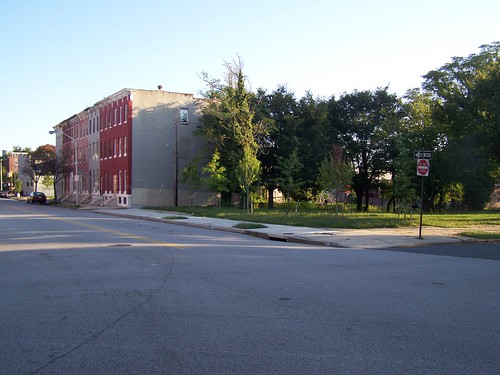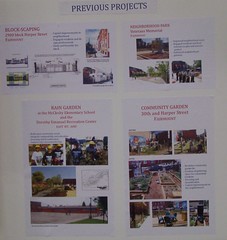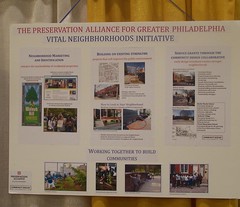I mentioned a couple weekends ago we went to Philadelphia to the Old House Expo. We stayed in the Mount Airy area, and the expo was in Germantown, so we went up and down Germantown Avenue.
Germantown Avenue spans a long stretch of Philadelphia, from distressed neighborhoods to very nice ones. This video (
Code of the Street video intro) done by students at Rutgers-Camden shows the context. (They did it because the first chapter of the book Code of the Street describes the changes along the street as a way to introduce the book and Philadelphia and the professor found that most of his students, hailing from suburban areas, didn't really understand the context.)
We stayed in a bed and breakfast, ate at a restaurant in Mount Airy (alas, the old North by Northwest restaurant-club had closed a year before), looked at a house for sale (not because we're moving but because that's a great way to assess an area), etc.
The areas where we were had looked pretty stable. But we were in a relatively healthy part of the city and the neighborhood, without fully realizing it.
But as we were leaving, we went into part of Germantown east of Germantown Avenue, not realizing that there would be significant differences, and we saw blocks of abandoned, boarded up and otherwise vacant housing. I didn't take any photos though...
This reminded me of parts of Baltimore--although Baltimore can be worse in terms of the level of neighborhood and housing abandonment--and it reminded me that the story of so-called urban revitalization is a lot more nuanced than we often acknowledge. It's really a neighborhood by neighborhood and commercial district by commercial district phenomenon and process.
Trends in downtown and central business districts, and resident attraction success there doesn't necessarily translate into improvements across the city.
Baltimore has plenty of vacant housing and vacant lots, even proximate to high value locations such as Penn Station. This block is about 4 short blocks from Penn Station.
I have mentioned before two Baltimore revitalization programs that are national best practice examples:
1.
Live Baltimore -- a resident attraction program that markets the city and neighborhoods and packages a variety of support services and financial incentives for people interested in living in city neighborhoods.
2.
Healthy Neighborhoods Initiative -- this program focuses more specifically on stabilizing declining neighborhoods, through targeted resident attraction and housing support programs (
about).
Not that Live Baltimore only focuses on healthy neighborhoods, it doesn't. But for example, the housing credit that existed for DC, giving people a $7,500 federal tax credit to purchase in the city wasn't targeted. So people got tax credits if they bought in Dupont Circle or Georgetown too, as the program wasn't developed to target neighborhoods more specifically in terms of stabilization objectives.
In Baltimore, the Healthy Neighborhoods program takes this idea one step further and provides more specific assistance to neighborhoods that really need it.
These are the kinds of programs that preservation groups typically do, which is a reminder of my point that most preservation and urban design groups in DC came to the fore during the period of the shrinking city, when the primary goal was stabilizing declining neighborhoods.
These programs are the kinds of programs that more center cities need to undertake in order to stabilize and maintain healthy neighborhoods.
Other important programs include:
Labels: urban design/placemaking, urban revitalization








0 Comments:
Post a Comment
<< Home